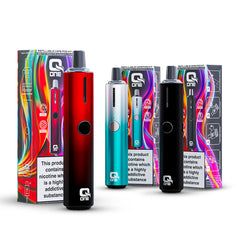A History of Vaping

A History of Vaping
If you are reading this, welcome nerd, glad to have someone who likes a little history here.
So, if you look at the mainstream, you’d believe that Electronic Cigarettes were a Chinese invention that appeared about 15 years ago and took the world by storm. What you won’t hear about is the 100 years of reinvention that came before it. The original countries of origin for these inventions, or why it took until recent years for it to be a successful product.
So, let's first look at what an Electronic Cigarette is.
Basically, it’s a battery, a wick, and a heating element. Power goes from the battery, into the heating element, and similar to a lightbulb; it heats up. The wick holds the liquid, and is wrapped around or passed through the heating element. When it heats up, the liquid evaporates and we get a vapour. Simple really. And it hasn’t changed from that original design either.
|
On the right here is the And on the Left we see the |
Do they look different? Sure, fundamentally though, the only real difference is the addition of a circuit board to control the power and the battery technology itself. Looking at the patent to the right, it had a wire leading into it after all…
So what is the main difference between then and now? The biggest difference is the battery technology. Back in the 1920’s we didn’t have Lithium Ion Batteries to discharge large amounts of amps into a circuit safely. With the invention of the Li-Ion Battery, we were able to create a much more portable design, and thanks to the work of Charles Babbage (inventor of the first computer in the early 19th Century) and then Federico Faggin (inventor of the key infrastructure of the modern silicon microprocessors in 1968) we were able to put in microcontrollers capable of managing the power without adding extra bulk or weight.
Moving on from the original, most of the research into the technology that would later become the modern day E-Cigarette was; weird, to say the least. One invention was a device that would electrocute the user when they used it to deter them from wanting to smoke… But, similarly there were devices that would contain lozenges intended to give a psychological relief from smoking. This would be similar to the Nicorette style inhalers that can be bought from most pharmacies.
In 1963, the most similar historical invention of the Electronic Cigarette was made by H.A.Gilbert. His patent was awarded in 1965.
In his patent, he had hoped that the “Smokeless non-tobacco Cigarette” (as he called it) could be used for more than just cessation, stating that it could be used for “inhaling warm medication into the lungs”-”under direction of a physician.”
His entire outlook on this device was for something that would reduce the negative effects of the tobacco industry and then furthermore, add a medically significant mode of treating people. If Herbert could see the stigmas surrounding the e-cigarette industry now, I think he’d be a little sad. Especially with the amount of work people have put into making it the best it could possibly be.
In 1997 however, a US patent for an “Electrical smoking article” was created by Philip Morris. As you’d expect from a tobacco company, they intended this device to be used with a tobacco flavoured liquid, though the device in their patent shows several indicators that technology still was not ready. The key point here? The battery.
As can be seen in their patent, the device that they devised still contained a bank of battery cells to achieve the output required. In their patent, they also listed ranges of output voltage without specifying any particular power source, only that the battery required must be able to output up to 20V as standard.
I think they intended using newer battery technology such as Lithium Ion batteries for this which had been invented in 1976 by Michael Stanley Whittingham, and subsequently developed further over the two decades since then, but Lithium Ion was not ready yet. It wouldn’t be till the turn of the century that we’d see the widespread use of Lithium Ion batteries extending beyond the early adopting phone companies.
Then in the early 2010s, we saw the appearance of the first commercially available Electronic Cigarette. Lets not beat around the bush here. They were terrible. But if we compare the first car to a modern Toyota Corolla, we’d say the same thing.
These first devices dubbed “Cigalikes” were made to imitate a cigarette in as many ways as possible. The end lit up like a glowing fag. They had 1 end coloured like a filter. They were often tobacco flavoured. But thanks to these devices, and the people who tried them, we quickly moved on.
Enter the Clearomizer!
Now we could refill our devices, buy just the liquid and replace when needed. These were much less wasteful than the prefilled cartomizer cigalikes, but they still weren’t great. Companies were playing with the types of metals used, cotton used, and how the coil was positioned. The best of these being the BVC clearomizer (CE5)or “Bottom, Vertical, Coil” where the coil was placed on end in the bottom of the device and the wick was wrapped around the outside. This was a game changer in terms of the performance of the devices, but the clearomizer wouldn’t last forever. The thin plastic shell and small contact area with the battery often left users with broken devices and as time went on, companies such as Aspire, Innokin, Vapresso and Smok moved away from this, choosing a design which would reduce the chance of accidental breakage both in materials used and the way they joined onto the device.
In the mid 2010s, we saw the rise of the cloud chasers, the sub ohm users, those guys that made you think you needed fog lights in the morning only to realise it was just Jim waiting for the bus…
These new devices looked to push the boundaries of what could be done with an Electronic Cigarette, and with it came the enthusiast that everything from cars with their gears heads to model trains have had over the years. These people tinkered with their devices, inventing many new methods of forming the various pieces of the device, creating the Clapton coil among many of the other small inventions that progressed the technology. Though, this part of the industry would not last, and while you will still see these enthusiastic cloud chases puffing away as they walk down the street, right around the corner was something that would change the face of the Electronic Cigarette industry, from a niche that no one really understood to something of a controversial issue.
2020 *coughs* 2021. The disposable. Yes, we’ve come full circle and now we’re back to the terrible Cigalike style devices. We’ve all seen them, we know why they’re controversial, but what drove their sales? Well, for one, chain stores didn’t need educating on them. For the first time, supermarkets and convenience stores were willing to stock the products. This is somewhat of a dilemma in terms of the industry as a whole though as while it means we have more access to smokers, everyone else also has more access to the product. Additionally, these products are, as the name suggests, disposable. As the technology progressed, and the companies investing into the technology made them better, so began the downward spiral of the public view. But, we’re not in 2021 any more. That horrible year of 2020 is even further behind us and in 2025, we are moving away from disposable products once again. With the UK as well as many companies banning the disposable e-cigarette, we are once again returning to the refillable, though this time marrying the convenience of a disposable with the functionality of an old style Tank.
Enter the Pod device. Now a few years old, the pod offers the best of both worlds. No mess replacing coils as the pod as a whole is replaced. Less waste as you refill the device with your liquid of choice. Harnessing the advancements made in the subohm sector with 0.8 and 0.6 Ohm (subohm being below 1 ohm resistance) coils, with a “mesh” design learning from the benefits of the clapton coil. The batteries are often metal, durable, and simple. Easy to pick up and use.
So, what will the future look like? I hope we can look back on 2025 and say that this was a turning point for the good of people. That the best these devices had; progressed. That H.A.Gilberts dreams of a device to help treat illness came true.
Products Related To This Article..



 QSeries
QSeries Innokin
Innokin Smok
Smok VooPoo
VooPoo Oxva
Oxva Uwell
Uwell Elfa
Elfa Ske
Ske Gold Bar
Gold Bar





